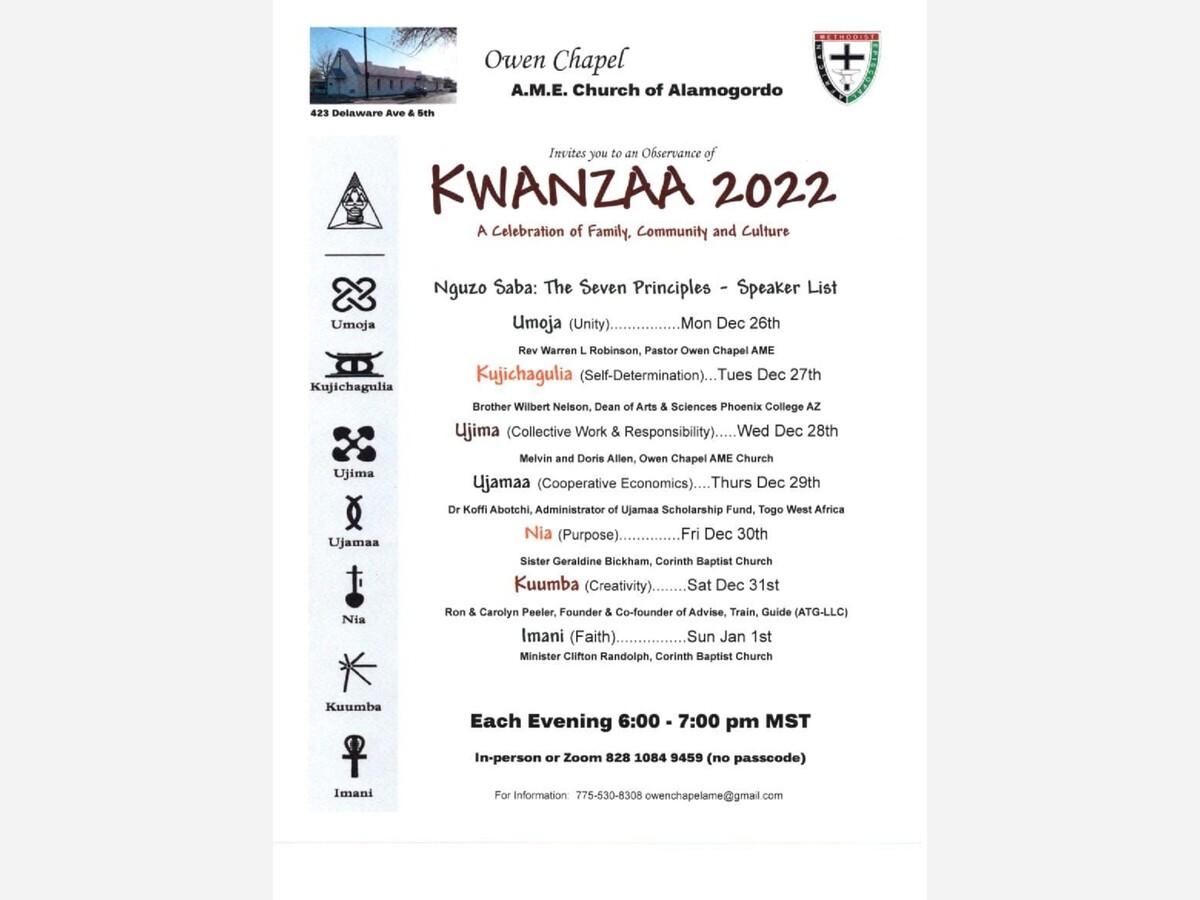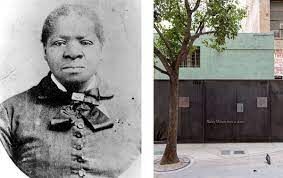Image


Holiday traditions run a gamut in Alamogordo with the diversity of cultures and the influence of the military on the region. With that influence comes a diverse set of holiday traditions to respect and learn from one another; from Hanukkah in the Jewish tradition to Advent and Christmastide in the Christian tradition.
Kwanzaa is a newer tradition taken from the African American experience. Kwanzaa is primarily an African American holiday, it has also come to be celebrated outside the United States, particularly in Caribbean and other countries where there are large numbers of descendants of Africans. It was conceived as a nonpolitical and nonreligious holiday, and it is not considered to be a substitute for Christmas.
Owen African Methodist Episcopal (AME) Chapel, at 423 Delaware Avenue, is hosting an Observance of Kwanzaa from December 26, 2022, thru January 1st, 2023.
"(With Kwanzaa) you don't celebrate just the decorations, but you celebrate the principles behind things," Owen Chapel pastor Rev. Warren Robinson said to Nicole Maxwell in an interview during a past celebration of Kwanzaa.
"When I grew up, I knew Santa wasn't coming down the chimney because we didn't have a chimney and if you did, what white man is going down my chimney?" Robinson said. "We were reality-based. It doesn't make sense. But we'll go along with the game because there's a present involved."
Kwanzaa celebrates the seven principles of Kwanzaa, or Nguzo Saba (originally Nguzu Saba – the seven principles of African Heritage). These seven principles are all Swahili words, and together comprise the Kawaida or "common" philosophy.
Each of the seven days of Kwanzaa is dedicated to one of the principles, as follows:
Kwanzaa celebratory symbols include a mat (Mkeka) on which other symbols are placed:
Supplemental representations include a Nguzo Saba poster, the black, red, and green bendera (flag), and African books and artworks—all to represent values and concepts reflective of African culture and contribution to community building and reinforcement.
Families celebrating Kwanzaa decorate their households with objects of art, colorful African cloth such as kente, especially the wearing of kaftans by women, and fresh fruits that represent African idealism. It is customary to include children in Kwanzaa ceremonies and to give respect and gratitude to ancestors. Libations are shared, generally with a common chalice, Kikombe cha Umoja, passed around to all celebrants. Non-African Americans also celebrate Kwanzaa. "Joyous Kwanzaa" may be used as a greeting during the holiday.
A Kwanzaa ceremony may include drumming and musical selections, libations, a reading of the African Pledge and the Principles of Blackness, reflection on the Pan-African colors, a discussion of the African principle of the day or a chapter in African history, a candle-lighting ritual, artistic performance, and, finally, a feast of faith (Karamu Ya Imani).The greeting for each day of Kwanzaa is Habari Gani?, which is Swahili for "How are you?"
At first, observers of Kwanzaa avoided the mixing of the holiday or its symbols, values, and practice with other holidays, as doing so would violate the principle of kujichagulia (self-determination). Today, many African American families celebrate Kwanzaa along with Christmas and New Year.
Cultural exhibitions include the Spirit of Kwanzaa, an annual celebration held at the John F. Kennedy Center for the Performing Arts featuring interpretive dance, African dance, song and poetry.
Locally Owen African Methodist Episcopal (AME) Chapel, at 423 Delaware Avenue, has been the center of African American Culture and the center of Kwanzaa celebrations of years.
Owen African Methodist Episcopal (AME) Chapel, at 423 Delaware Avenue, is a very welcoming environment open to all colors, creeds, ethnicities and the LBGTQ+ community.'
Sunday in many cities of America is a day of segregation. Sunday, whether intentional or non-intentional, is arguably the most racially segregated day of the week in America. Whether one attends worship services in a church located in the urban core, a suburban area, or in the valleys and hillsides along winding country roads, it is very likely that the parishioner beside us or across the aisle is of the same race if not the same ethnic group.
Many of us gather in the pews Sunday after Sunday, unbothered and unfettered by the racial homogeneity all around us, even when the edifice and its distinct steeple peers from a neighborhood whose residents may or may not be homogeneous at all. A neighborhood made up of a variety of racial and ethnic groups, members of which have never dared to dawn the church’s entrance, or never invited to come in.
The National Congregations Study, which conducted surveys in 1998 and, most recently in 2006—07, confirms that the vast majority of churches throughout the nation are made up of members of the same race or ethnic group. (Findings of the National Congregations Study can be found at http://www.soc.duke.edu/natcong/ )
At first glance, the “Sunday Self-Segregation” phenomenon is easily understandable. After all, our religious beliefs and methods of worship are extensions of our family life, whether Catholic or Protestant, Islamic or Judaic, or some other religion. So, it comes naturally to gather with “our kind.” To do otherwise present a kind of what we instinctively feel is an unwanted and unnecessary dissonance when we find ourselves outside of “our comfort zone.”
Such dissonance is often palpable for the visitor who goes to a church predominantly of a different race, as well as those he or she visits. So, what does that say about our willingness to invite, accept, include others — a brotherly deed that the very religion we embrace teaches and urges us to practice — who on the surface may look and live very unlike us?
Though we may see more diverse congregations in some areas, and certainly on some televised religious services, integrated congregations are far from being the norm.
To break that cycle and open my eyes a year ago I spoke with the Reverend Robinson on this issue, and he invited me to attend his service and see that diversity does exist within the traditionally Black Church of Alamogordo. What follows is an excerpt of a story we ran over a year ago of that experience and why we continue in our membership and support of Owen AME Chapel and a more diverse Alamogordo Community...
Rev. Robinson invited me to visit his church, and to attend a service. So with that invitation, instead of my catching up on sleep on Sundays, as per my normal routine, I took the Reverend up on his offer, and joined his services, today.
At 10:50 I entered the small very cozy and comfortable church. I was warmly received and settled into my pew toward the back of the church. Every member made it a point to come up and say, hello throughout the day and to make me feel very welcome. The service was unique to me in that it also included several lessons in history of the black experience.
One was of the only white woman killed in Alabama by the Klan during the fight for integration and equality of the 1960s, one of the founding family of the AME Church in Alamogordo in 1932 and one of a very interesting former slave from Mississippi that went from slave in 1812 through a journey to Utah and ultimately to Los Angeles where she fought for her freedom and won it.
This story was of Bridget “Biddy” Mason who was born August 15, 1818. This inspiring woman not only got her freedom, she became a land owner in Los Angeles, created the first for pay parking lot in LA during the times of horse and buggy and ultimately gained wealth that would make her a multi-millionaire in modern times.
At her death, Mason was one of the wealthiest women in Los Angeles. For reasons never fully explained, she was buried in an unmarked grave at Evergreen Cemetery. In the years after her death, a bitter family feud erupted over her estate; once it was finally settled, the “Mason Block” was put in the hands of her grandson Robert, who became the wealthiest black man in Los Angeles County. The family held onto Mason’s cherished “first homestead” until the Depression.
Over the past 30 years, Mason’s memory has been reclaimed by the city of Los Angeles. In 1988, at a ceremony attended by Mayor Tom Bradley, the First AME Church placed a memorial stone on her unmarked grave. A year later, a memorial in her honor was erected in a small park behind the Bradbury Building near Third and Spring. But perhaps the best memorial to Biddy Mason is her own words, remembered by her great-granddaughter Gladys, decades after her death:
If you hold your hand closed, nothing good can come of it. The open hand is blessed, for it gives abundance, even as it receives.

The lessons of Biddy Mason were alive and in practice at the AME Church in Alamogordo this fine Sunday.
At the conclusion of the service, a meal was served to all who attended the service and welcome to all and anyone in Alamogordo. The pastor explained to me that, "those who pray to together and dine together, stay together." All day long, I've reflected on those words, and I do believe Pastor Robinson to be progressive in his approach to the ministry and wise. When I asked about the small numbers in attendance, he explained to me very kindly. that YouTube and the internet are equally important to the modern church.
I enjoyed the service today, at Alamogordo's Owen AME Church. The church was a true diverse experience with a large number of Caucasian congregants, which should not have surprised me.
That was always the case in San Francisco at the AME services by the Dr. Rev Cecil Williams as well. But in Alamogordo, I was not sure, what to expect. What I found, was a congregation with a heart bigger than the vast church of Cecil Williams in San Francisco, but equal in its mission to serve the word of faith.
Thank you, Reverend Robinson, for the invitation. And thank your congregation for their warm wishes and hospitality. I was and am honored, I found today to be a very fond day in Alamogordo, and for that, I too give thanks.
Let's get more people in the community to support this small, historical and very important house of worship to our community. Services are every Sunday at 11 am and they are open to everyone! Everyone welcome was truly practiced at this house of worship.
Alamogordo's Owen Chapel AME Church concludes every Sunday service with a potluck meal that everyone in the community is invited to. The practice of breaking bread with a neighbor, looking them in the eye and having dialog further builds a sense of community and breaks down divisions of our community.
Join Owen Chapel AME for one of the nights of Kwanzaa learn and expand your understanding of the diversity and the beauty of the Alamogordo Community. Everyone is always welcome!